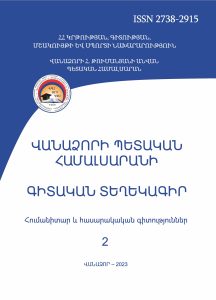Features of the Organization of a Multi-perspective Narrative of Levon Khechoyan’s Historical Novel “King Arshak, Eunuch Drastamat”
Scientific Proceedings of Vanadzor State University Humanitarian and Social Sciences (ISSN 2738-2915)
2023 vol 2
Features of the Organization of a Multi-perspective Narrative of Levon Khechoyan’s Historical Novel “King Arshak, Eunuch Drastamat”
Tina Ayvazyan
Summary

Key words: polyphony, narrator, narrative methods, structure, the death of the author, intertextuality
The organization of the narrative, using folklore genres and narrative techniques with the combination of new techniques, makes it possible to convey life experience and artistic ideas from generation to generation, ensuring the continuity and actuality of literature.
The epic narrative of Levon Khechoyan “King Arshak, Eunuch Drastamat” is created according to this principle. The historical novel, generally, reflects those features of narrative organization (changes in the point of view, intertextual connections), that are observed in the literature of the 20th century. The innovative nature of the historical novel and the most important characteristics of story construction have not been unnoticed, just on the contrary: they have always been highlighted by researchers.
Literary scholars, who have studied the historical novel, have noted several unique features of the structure of the narrative, hovewer, with all the depth of the analytical research and notes made, the regularities of the narrative organization have not been studied specifically. Therefore, it is relevant to study the historical novel from this point of view.
The aim of this article is to examine the features of the narrative structure found in L. Khechoyan’s historical novel “King Arshak, Eunuch Drastamat.” To this end, we have assigned ourselves the task of examining the primary structure of the narrative, the viewpoint, and the various ways in which it is expressed in the aforementioned novel.
